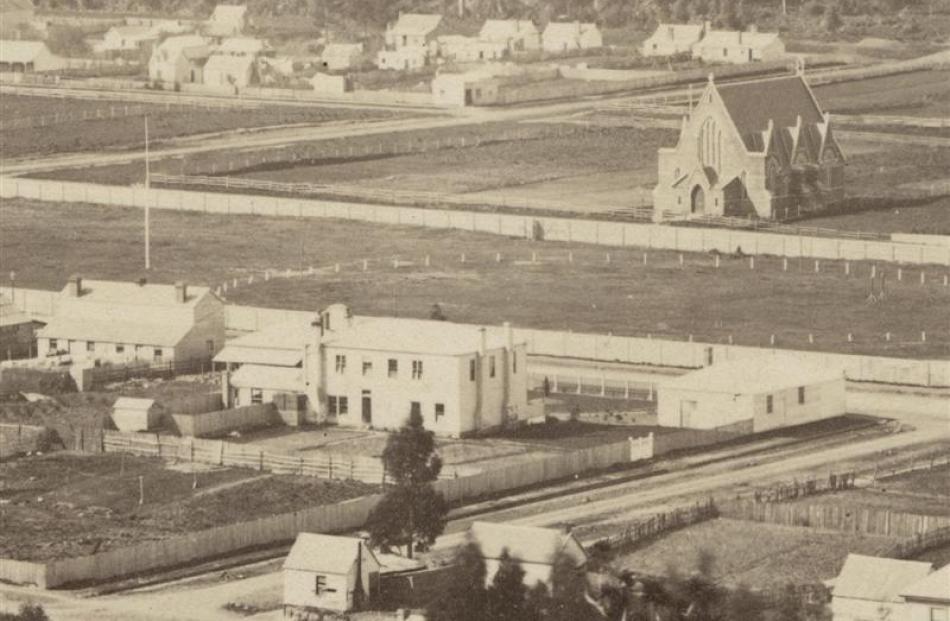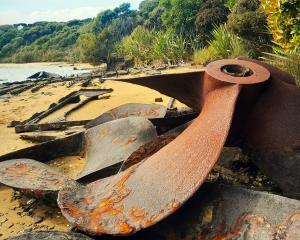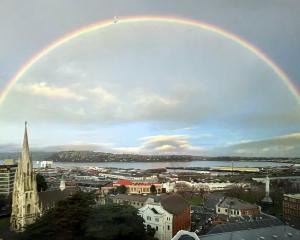A magnificent Wellingtonia, thought to be more than 140 years old, stands opposite the North Ground on Great King St.
Its great height gives context to the even older wooden building behind it: Albyn House.
Built as the Albion Hotel, it predates the Otago Gold Rush, and might be the oldest surviving building in North Dunedin.
An early photograph shows the hotel set back from a roughly formed street, in almost rural isolation.
A traveller in 1861 observed only two notable buildings in North Dunedin: the original Knox Church and the Albion, which he thought ''for external appearance and internal comfort is superior to any in Canterbury''.
The two-storeyed structure appears modest now, but it was impressive in newly-hatched Dunedin, and a storekeeper in Great King St advertised his business as ''nearly opposite that magnificent building, The Albion Hotel''.
The architecture draws from the Georgian tradition, and with its small central pediment is reminiscent of George Greenfield's design for the custom house (built 1862, demolished 1973) in High St.
Where the custom house was stone and brick with a portico, timber materials and a veranda gave the Albion a more Colonial look.
Arches and six-pointed stars were striking features of the entrance porch.
The first proprietors, John Henry Noding and Ernest Cleland Mais, were granted a licence in April, 1861, but by October, Noding was the sole proprietor.
Like many advertisers, he indulged in a little exaggeration, claiming the accommodation he provided was ''unsurpassed in the Colony, combining the freedom of a hotel, with the comforts of an English home''.
Robert Ellis opened livery and bait stables in connection with the hotel.
A curious incident made the papers at the end of 1861.
Noding claimed that one of his guests, Captain Peter Greig, had demanded alcohol after hours and been very noisy, ''playing leap frog and other improper games in the parlour''.
Greig was asked to leave, but refused and threatened to horsewhip his landlord.
On Noding's instructions the housemaid turned out the captain's belongings and locked his bedroom, but he broke down the door.
He was later prosecuted, and following his spirited defence the magistrate remarked that he was obviously still under the effects of excitement.
Greig apologised, explaining that he was not well, his feet were damp, and he had on a pair of new boots, which hurt his feet.
He was ordered to pay damages, but fellow guests claimed he had done nothing wrong and criticised Noding as a poor host and a difficult man to live with.
Five of them left the hotel in solidarity with the captain, and signed a letter in his defence, published in the Otago Daily Times.
John McNeill bought the Albion at the end of 1862, and soon altered and reopened it, advertising ''delightfully airy'' bedrooms, private sitting rooms for ladies, and all the comforts of home.
The table, he boasted, was ''daily furnished with every variety and luxury of the season, and the very best wines''.
Within months the hotel changed hands again, with James Flannagan the new publican.
Members of the North Dunedin Cricket Club held meetings in the building, including one on February 6, 1864, the day they officially opened the North Ground.
On one occasion, a perambulator was stolen from the veranda and taken on a little adventure as a ''lark'' - evidence, should it be needed, that pranks by drunks in the area predate the University of Otago and its students by some years.
Flannagan failed to make a success of the business and the hotel closed in 1865.
After being bought by the mortagees, John McNeill and James Finch, it was sold to Daniel Campbell in 1866.
For the next 18 years the building was Campbell's private residence, and was known as Albion House.
Campbell had arrived from Edinburgh in 1851, and was the first printer and manager of the Otago Witness, and later managing director of the Otago Daily Times.
Two of his daughters were married at Albion House by Rev Dr Donald Stuart. Campbell left Dunedin in 1883, and in 1884 a boarding house was established in the building by Mrs Susan James.
She initially leased the property before buying it in 1888, when she changed the name Albion House to Albyn House.
Albion is the oldest known name for the island of Great Britain, and Albyn is a variant with romantic literary associations.
It is not known why Mrs James changed the name, but it may have been to avoid confusion with another Albion House, or the Albion Hotel in Maclaggan St.
Susan James ran Albyn House until 1901, and after leasing it to other operators returned to a hands-on role from 1908 to 1914.
Later proprietors included Jane McIvor (c.1919-1932), Annie Christeson (c.1937-1966), and Ivy Harborne (c.1967-1976).
Residents in the early years included clergy, medical students, clerks, and music teachers.
Notable individuals included W. H. Trimble, who became the first Hocken librarian, and Whampoa Fraser, the first principal of what is now Fraser High School in Hamilton.
Albyn House was also used by tourists and travellers, and increasingly by those looking for low-cost accommodation.
Some additions to the building have been removed, as have the brick chimneys that were attached to the external walls.
Decorative ironwork that once graced the frontage has also gone, and aluminium-framed windows make incongruous replacements for the original double-hung sashes.
The veranda was partially closed in during the mid-20th century.
After 154 years however, the building retains the essentials of its original character.
The buff colour scheme, of a type once common, adds to its old-fashioned charm.
Albyn House is significant, not only as possibly the oldest building in North Dunedin, but also because it is likely Dunedin's oldest remaining hotel building.
It survives as one of the few built links to the city's early pioneer days.
• For more from David Murray go to builtindunedin.com
Albyn House
Built: 1861
Address: 558 Great King St
Architect: Not identified
Builder: Not identified












